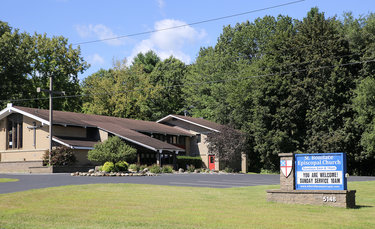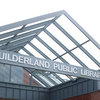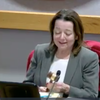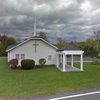Church permitted to display ‘public service’ messages on digital sign
GUILDERLAND — A church in town will be able to post on an electronic sign messages that are forbidden for Guilderland businesses.
Saint Boniface Episcopal Church was recently given approval to display “religious institutional messages” on an eventual Western Turnpike digital sign after the Guilderland Zoning Board of Appeals determined that the display would constitute “public service information,” exempting it from a town law governing messaging on electronic signs.
The determination applies only to Saint Boniface, and permits the church to submit an application for an electronic message board.
As it stands, “each individual church” seeking to display messaging “would have to submit their own application,” Chairwoman Elizabeth Lott explained during the board’s Aug. 20 meeting.
In 2022, after the town was made aware of what some residents had thought was a violation of a local shopping center’s sign permit, Jacqueline Coons, Guilderland’s chief building and zoning inspector, made the determination that no enforcement action was needed.
Some residents had felt the Town Center Plaza at 1704 Western Ave. was not following the conditions of approval laid out in its permit for an electronic digital sign meant to act as a tenant directory. Apartments were being advertised on the sign that should not be advertised, residents asserted, as well as classified ads.
The zoning board in June 2022 ultimately determined it was the intention of the board at the time the plaza’s sign permit was granted, in 2020, that the electronic directory sign would display only board-approved signs that already appeared on Town Center’s buildings.
“Specifically, the signs displayed must match or be the same as the signs on the Town Center storefronts which were previously approved by the Zoning Board of Appeals after undergoing the sign permit process,” Lott said at the time.
The protracted sign saga led to the town board adopting new zoning language that stated, “No electronic variable message, automatic changeable copy, or programmable digital signs shall be permitted, except for the non-flashing display of time, temperature, and/or date, public service information, or fuel prices at automobile service stations.”
In its request for an interpretation, Saint Boniface argued, “Religious organizations serve the public in ways that extend far beyond religious services. Through charitable assistance, mental health support, education, community building, and healthcare initiatives, they provide essential services that benefit society at large. Recognizing religious organizations as entities that perform a public service is not merely a religious argument but a practical one — these institutions help fill gaps in social services, reduce government burden, and improve the overall well-being of communities.”
The public
The broad consensus of the half-dozen speakers who commented during the Aug. 20 public hearing was that churches provide meaningful public service and can act as civic partners, but there was also concern about light pollution and similar future requests.
Susan Edwards, a parishioner at Saint Boniface speaking on behalf of the application, emphasized that churches provide more than worship; they function as community-service providers offering programs and support that benefit the wider public, citing as examples youth programs, childcare, grief counseling, Alcoholics Anonymous, donation drives, emergency shelter, and blood drives.
Edwards also noted churches’ roles in building community through monthly dinners, visits to the homebound, and social justice efforts. These services, she argued, help to fill gaps the government cannot always address.
Neil Satterly, a parishioner at Lynnwood Reformed Church, said, “I will echo what [Edwards] said in her justification,” and “add a few things of my own.”
For an aging congregation, Satterly explained, physically changing letters in winter weather can be burdensome. Saint Boniface currently has a sign where letters are applied by hand, as does the Lynnwood Reformed Church.
Satterly said his church currently uses a traditional lit sign with movable letters, which he described as “the Gutenberg version of signage,” a reference to the Gutenberg Bible, the first printed version of the Bible, from 1455.
But Satterly also had “concerns about light pollution.”
He said, “I'm a strong critic of it and believe there should be a way to either turn these signs off or dim them at night. Some of the signs I've seen are blinding in the middle of the night, and that's not right. We need to address this issue so we don't tarnish the reputation of what these signs can do.”
If used properly, Satterly said, “these signs are a great benefit.” He cited as an example the sign at the Fort Hunter firehouse, “where they show how many calls they've made to date. This information is important and meaningful to the public.”
Later in the hearing, Satterly offered a second comment, proposing that the town consider forming a working group or committee to address the issue holistically, rather than on a case-by-case basis. He pointed out that, if one church’s interpretation was granted, it would naturally prompt similar requests from other congregations and potentially other not-for-profit organizations.
Developing a uniform policy or guidelines now, he argued, would prevent future disputes.
Ellen Manning, a McKownville resident, said that, when she looked up the term “public service,” the definition she found described it as a service provided by the government, adding, “I don't know if the town code defines your use of the term, but that’s for you to figure out.”
(Save for the single reference in the signage section of the town code, nearly all other mentions of “public service” relate to either the New York State Department of Public Service or the New York State Public Service Commission.)
While admitting she hadn’t read the entire narrative submitted to the board, Manning concluded her brief statement with, “I'm not sure if the proposal is for a moving sign or just an electronic sign with a static message. To me, anything like that is a distraction. That’s all.”
Charlie Giglio, a Saint Boniface warden, told the board members, “We agree with what has been said. If we are approved, we are looking for an automatically dimmable sign that would not be glaring at night.
Giglio also said, “We’re not trying to be a spectacle like a Barnum and Bailey Circus, and we don’t want to be a distraction. We just want to get a quiet message out, reach the community, and be helpful. We want to continue being good neighbors and don’t want to upset people.”
The board
While the board unanimously approved the Saint Boniface application, members questioned whether the town board should step in and deal with the matter.
“The term in question is ‘public service information.’ It is not defined anywhere in the town code,” Lott said.
When she researched the phrase, she said, “The only definition I found was in the state of Washington’s laws on highway signage,” which defines public service information as: “A message on an electronic sign that provides the time, date, temperature, weather, or information about nonprofit activities sponsored by civic or charitable organizations.”
Lott said the Washington state definition “seems closer to what has been described in tonight’s application. It would include religious organizations as part of nonprofit organizations that provide public services.”
She said that, when the town board adopted the electronic sign language, “the intent appeared to be to prohibit commercial electronic messaging — business advertising—while still permitting certain noncommercial uses. Businesses could not advertise goods and services, but entities could post time, date, temperature, public-service announcements, and fuel prices in a non-flashing format.”
Lott also noted, as part of the update to Guilderland’s comprehensive land-use plan, the issue was looked at by the neighborhoods and housing subcommittee
She said the subcommittee recommended to the town that it “adopt a comprehensive plan that would incorporate better ways to bring the community together.”
And one of the things suggested, Lott said, “was that, if someone can’t get to the senior center or can’t get to the library, maybe they can get to the fire department in their neighborhood, or the nearest church, or some other community building that isn’t necessarily run by the town and the government,” but is “partnering with the town to provide services when we need them.”
Board alternate James Zieno said, “I think it would be better suited for the town board to add nonprofits and churches to the text of the town code.”
Zieno was just weighing in on Aug. 20; he wasn’t sitting in for any absent board member.
“I think public-service information is generally accepted to be a government term when the government absolutely needs to get information out to people,” Zieno said. “That obviously applies to libraries and schools too, because they are part of the government, but it's less I would say life or death as like a fire district.”
Zieno said he wouldn’t have been in favor of the motion to approve.
Zoning board member Kevin McDonald, while acknowledging he was “not a big fan of the electronic signs,” said he understood the reasoning for approving the request and voted in favor of it, adding, “And I would hope, again, what [Zieno] had said about the town board maybe having some regulation on size and what happens as far as light and no flashiness, but the message is important for the community.”



